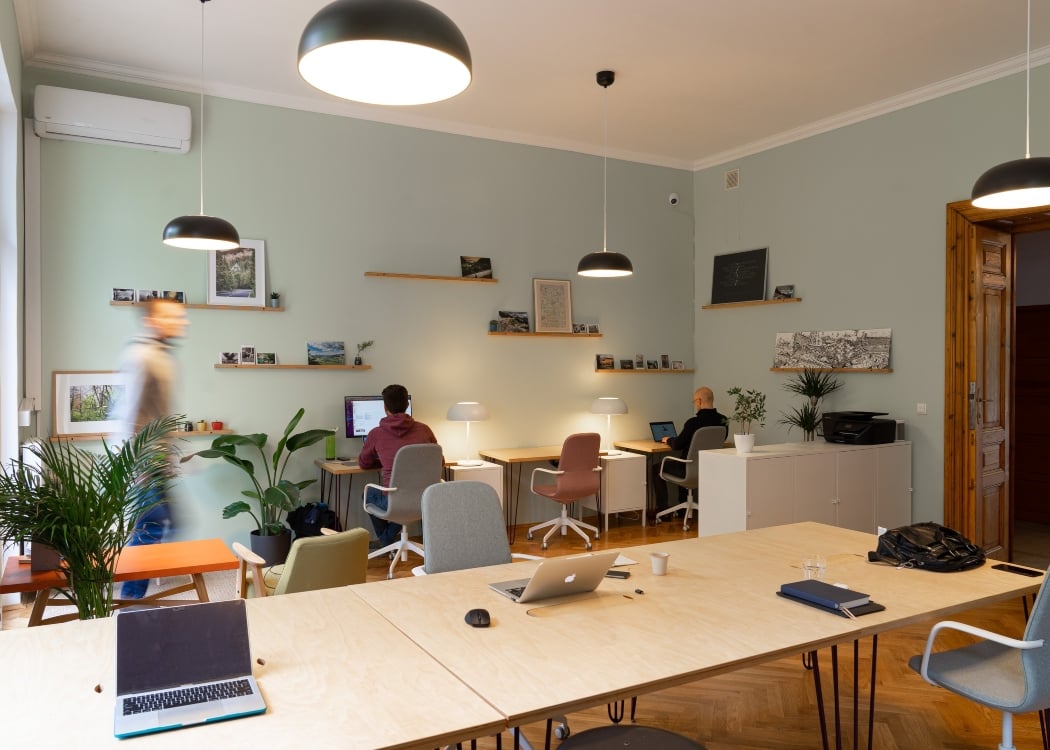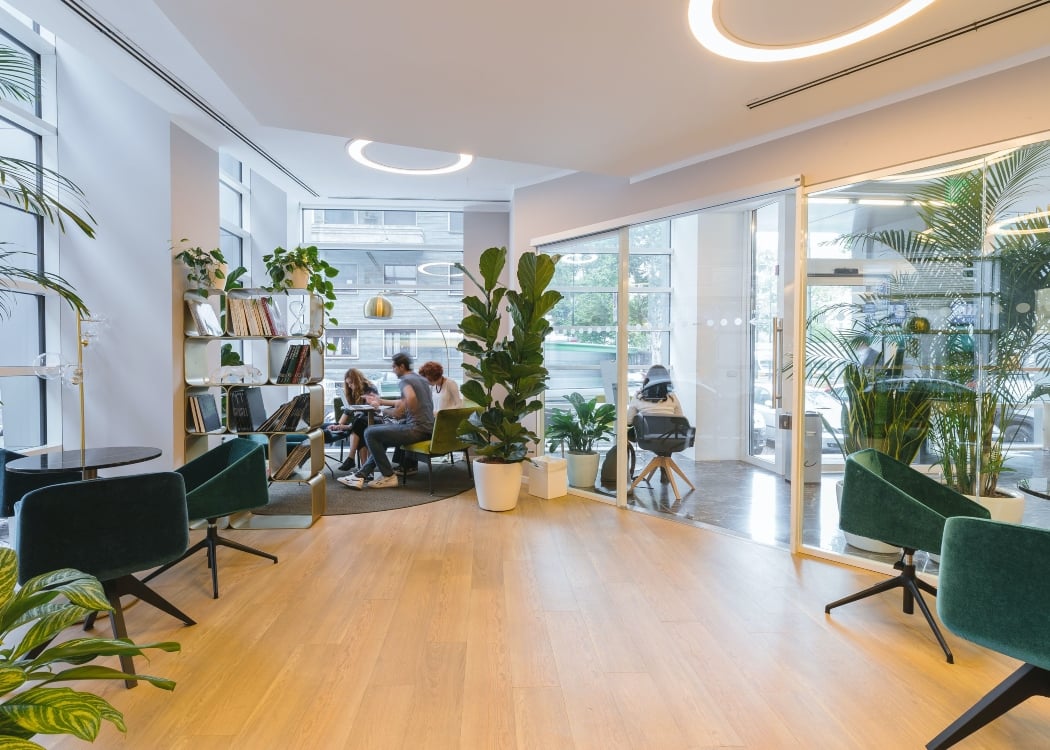
Want to talk it through?
Our experts know London’s office market inside and out, and our service is entirely free. So whether you need co-working, flexible or private office space, our team are here to help.

Covid-19 has re-ignited the ‘dispersed workforce’ debate – with the hub and spoke model speculated to gain traction. But what is a hub and spoke model? Will it be widely adopted in the post-Covid workplace? And what are the benefits of working closer to home?
The office was a hot topic last year. But amid countless debates around its role, a single buzzword took the lead time and time again. The demand for ‘flexibility’ trumped all.
Covid-19 revealed the extent to which businesses and their employees want the freedom of choice. In turn, the pandemic accelerated several alternatives to the traditions of our working lives – for both ‘how’ we work and ‘where’ we work.
Though working from home is unlikely to (and probably shouldn’t) become the be-all and end-all of your workplace strategy, it’s been a useful stand-in with some merit. Notably, it allows us to trade in time previously dedicated to commuting for something more enriching – be it a mindful morning, a workout or quality time with loved ones.
But on its own, working from home hinders any meaningful employee development, collaboration and innovation. While it could form part of your real estate strategy, there’s another option to consider: working closer to home.
Get your monthly dose of workplace insights, productivity hacks and business leadership ideas - delivered straight to your inbox.
 Covid-19 revealed the extent to which businesses and their employees want the freedom of choice. In turn, the pandemic accelerated several alternatives to the traditions of our working lives – for both ‘how’ we work and ‘where’ we work.
Covid-19 revealed the extent to which businesses and their employees want the freedom of choice. In turn, the pandemic accelerated several alternatives to the traditions of our working lives – for both ‘how’ we work and ‘where’ we work.
Before this ‘great workplace experiment’, the archetypal commute was an age-old tale. It began in a quiet, leafy town and ended over an hour later in a busy city centre. For drivers, it was a race against gridlock. For season ticket holders, it was a race to find a seat.
But even pre-Covid, as far back as 1973, the commute from suburbia to city was being challenged – by eco-warriors. As we explored in our History of the Office, ‘telecommuting’ was posed as a workaround to ‘traffic, sprawl, and scarcity of non-renewable resources’ by Jack Nilles, a former NASA engineer.
The goal was to shorten commute times by encouraging workers to spend their 9-5 days at local offices closer to home, rather than trek into congested cities.
Nilles’ ‘telecommuting’ idea isn’t so different from the trends predicted for our post-Covid world of work. With our newfound focus on workplace flexibility and an appreciation of the office’s role, some businesses are starting to consider ways in which they can find something in between working from home and commuting to the office.
In fact, 47% of UK businesses surveyed by Knight Frank are considering how their employees could work closer to home, while 21% of businesses said they were looking at operating offices closer to where people live. A hub and spoke model might be one way to achieve that.
In the world of office space, a hub and spoke model includes a primary HQ (the hub), often in a city centre, combined with local, satellite offices closer to where employees live (spokes).
Crucially, hub and spoke models provide teams with access to office amenities, but with the flexibility of being closer to home. By giving employees the option to work closer to home, rather than at home, satellite offices can prevent the pitfalls of remote work (such as isolation, poor collaboration and makeshift desk setups), but also mirror some of its benefits, such as less time spent commuting.
From an employee’s perspective, high-speed broadband, a dedicated desk, and a designated work environment (which doesn’t need to be actively protected from domestic distractions) might be a welcome relief. And from a business’s perspective, management of both employees and the physical operational environment is easier.
 By giving employees the option to work closer to home, rather than at home, satellite offices can prevent the pitfalls of remote work (such as isolation, poor collaboration and makeshift desk setups).
By giving employees the option to work closer to home, rather than at home, satellite offices can prevent the pitfalls of remote work (such as isolation, poor collaboration and makeshift desk setups).
The hub and spoke model also gives businesses access to a wider pool of talent. We know that office space is a strategic device used to attract and retain the best of the best, so a wider geographical net of high-quality work environments could tap into a broader range of talent outside of the UK’s cities.
An exceptional candidate based outside of London, for example, might be put off by losing three hours of their day to a commute. But if your hub and spoke model meant that they only had to travel into London once a week, and could spend the remaining four days in an office 20 minutes down the road, they’re far more likely to consider the role.
Working from home comes with a set of security risks and privacy concerns. In fact, as we explored in our blog, How to Create a Flexible Working Policy, data security risks have increased over the past few months. During lockdowns, fraudsters have tried to exploit employees’ unsecure domestic Wi-Fi networks.
Likewise, workplace health and safety is near impossible to effectively manage when employees are working from home. Unless you’ve provided your employees with the right equipment (or they’re fortunate enough to have space for a home office) they’re likely to be using makeshift desks, such as kitchen tables, sofas or even beds. Poor office furniture can have serious implications on our bodies, minds and productivity levels.
If working closer to home is viewed as an alternative to working from home, the controlled environment of an office can help to alleviate the associated safety and security risks.
While future adoption may be more prominent, few have embraced the hub and spoke concept so far. Writing in Knight Frank’s M25 Offices, Darren Mansfield, Partner, Commercial Research, explains: "With the pandemic unresolved, firms will be reluctant to pursue a new strategy without indication of the business environment in which they will be operating.”
He continues: “Satellite occupations may test the market. A landlord and tenant relationship based on service and increasingly flexible lease terms was already gaining traction prior to Covid-19 and has been more evident in 2020. A corporate push toward this type of configuration will clearly escalate this process, but landlords will be wary of losing the potential to secure longer-term income.”
But, as he says, flexible office space might be key here in inviting businesses to try it out: "Coworking and serviced office providers would be the obvious candidates to create this network.”

The logistics of arranging a hub and spoke network might prove to be incredibly difficult, especially if your workforce is scattered in every corner of a main city. So, how do you begin the mammoth task of mapping out your offices in accordance to where people live?
“Some property analysts have pointed towards a hub and spoke model becoming more popular. This may be the case in large cities such as London, but it is unlikely to work in Edinburgh and Scotland more generally where conurbations tend to be smaller and commuting to central offices is less time-consuming.”
Meanwhile, the logistics of arranging a hub and spoke network might prove to be incredibly difficult, especially if your workforce is scattered in every corner of a main city. So, how do you begin the mammoth task of mapping out your offices in accordance to where people live?
Areas on the outskirts of London locations and across the wider South East region have the potential to offer spoke locations that work in tandem with central London offices. Using a range of factors and market insights, Knight Frank’s M25 Offices highlights some of the best places to set up local satellite offices in a hub and spoke model.
Based on the local business environment, Hammersmith leads the way, followed by Croydon then Reading. For combined connectivity, Wimbledon sits in first place, followed by Richmond, then Hammersmith.
 47% of UK businesses surveyed by Knight Frank are considering how their employees could work closer to home, while 21% of businesses said they were looking at operating offices closer to where people live. A hub and spoke model might be one way to achieve that.
47% of UK businesses surveyed by Knight Frank are considering how their employees could work closer to home, while 21% of businesses said they were looking at operating offices closer to where people live. A hub and spoke model might be one way to achieve that.
It’s clear that Covid-19 has re-opened the ‘dispersed workforce’ debate. In fact, ‘better but more dispersed space’ is a dynamic within Knight Frank’s 12 Dynamics of the Post-Covid Workplace. We know that choice and autonomy will be paramount to any business’s future real estate strategy.
But the hub and spoke model certainly has its merits. As Darren Mansfield explains: “Embracing the hub and spoke model and providing flexible working solutions could be the answer to key human resource challenges.”
Likewise, in the current climate, easy-to-reach satellite offices that don’t require employees to use public transport might be an attractive option for some, especially as a substitute for working from home. But flexible offices will be crucial in allowing businesses to test the waters.

Our experts know London’s office market inside and out, and our service is entirely free. So whether you need co-working, flexible or private office space, our team are here to help.